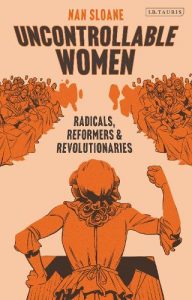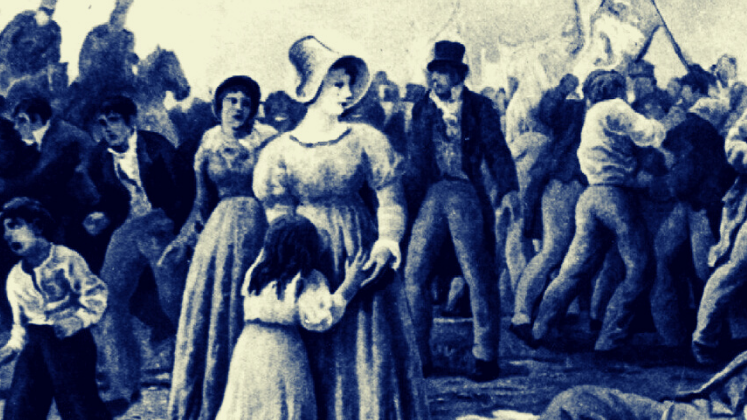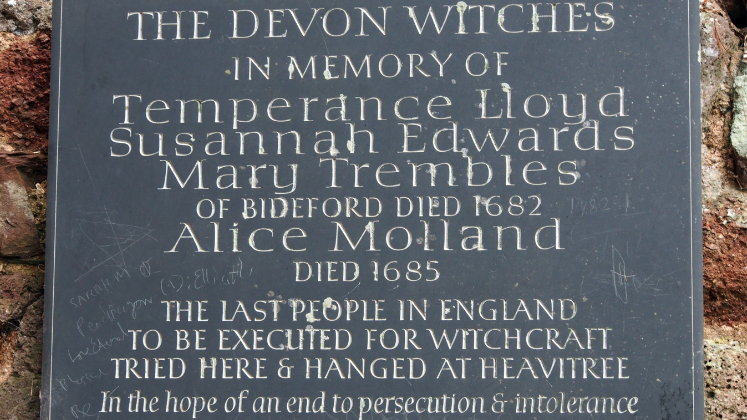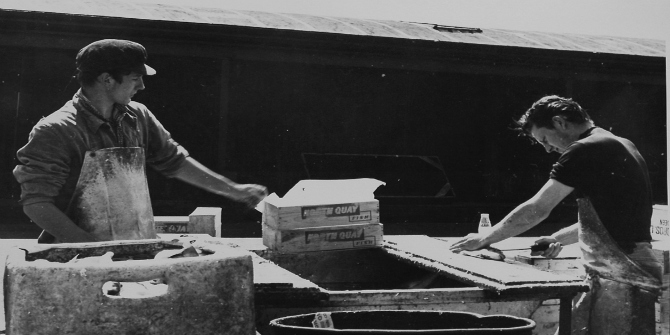8 March is International Women’s Day. To celebrate the occasion, Nan Sloane draws from her recent book, Uncontrollable Women (Bloomsbury), to argue for the importance of recovering and reclaiming working-class women’s early radical voices.
‘Victory is ours’: Reclaiming Working-Class Women’s Early Radical Voices
 The story of Mary and Lydia Molyneaux’s fifteen minutes of fame is soon told. In April 1812 these sisters were involved in a riot which burned down a silk mill near Bolton in Lancashire. They were not passive observers – far from it, they were seen ‘with Muck hooks and coal picks in their hands, breaking the Windows of the Buildings and swearing and cursing the souls of those that worked in the Factory.’ They egged the men on to burn it down, shouting ‘Set fire to it! Now lads!’ The lads obliged, and the resulting blaze was enormous, causing £6,000 worth of damage, a huge sum for the time.
The story of Mary and Lydia Molyneaux’s fifteen minutes of fame is soon told. In April 1812 these sisters were involved in a riot which burned down a silk mill near Bolton in Lancashire. They were not passive observers – far from it, they were seen ‘with Muck hooks and coal picks in their hands, breaking the Windows of the Buildings and swearing and cursing the souls of those that worked in the Factory.’ They egged the men on to burn it down, shouting ‘Set fire to it! Now lads!’ The lads obliged, and the resulting blaze was enormous, causing £6,000 worth of damage, a huge sum for the time.
Lydia and Mary were arrested and hauled off to Lancaster Gaol, where they were tried for the capital offences of arson and riot. Despite the evidence against them, they were acquitted, possibly because juries did not like hanging very young women. So far as we know, they returned home and never troubled either the law or the history books again.
Mary and Lydia Molyneaux are a tiny and little-known illustration of the problem of tracking down working-class women and the parts they played in major events. The attack on the silk mill was part of a wave of Luddite activity in Lancashire and Yorkshire in 1812. Whilst it is clear from stray tales like this that women were involved, and could even be ringleaders, they are so hard to find that the generally accepted view is that, whilst women might encourage their menfolk, their role was largely passive.
Sometimes all we have are names and a single action – who, for instance, were Nan and Clem, described by the radical Samuel Bamford as ‘the tall, dark-haired, and handsomely formed daughters of a venerable old weaver’, who set fire to a mill-owner’s house at Middleton, near Manchester? ‘Come’, said one to the other as she set fire to a sofa, ‘let’s put a finish to this job.’ This is all we know of these two women. We can deduce from accounts of the conditions at the time what might have driven them to this extreme, but we can never know for sure. Perhaps they were out of work, cold, tired and hungry. Perhaps they just thought setting a big fire would be fun. Perhaps they thought all of these things, or none. All we actually have is their first names and eight words supposedly uttered by one of them and reported by someone who was not there at the time and was therefore relaying these details at second-hand at least.

Image Credit: Cropped and filtered image of ‘Painting in Free Trade Hall by A. Sherwood Edwards’ depicting Peterloo. From Annals of Manchester, ref 942.73 C5. GB127.m07598. Licensed by Manchester Archives+ under CC BY NC 2.0
Middle-class women at the turn of the nineteenth century are much easier to find and to hear directly. Hundreds of them wrote poetry, novels, articles, educational works, works for children, religious essays, tracts against the slave trade and other evils and, in a few brave cases, political philosophy. Women’s writing sold well, publishers actively looked for it and quite a lot of it survives.
For working-class women it was always different, although, contrary to what is often assumed, many in the late eighteenth and early nineteenth centuries could read, and a reasonable proportion could also write. They were taught these skills at a variety of small schools run by all kinds of people and organisations. By the Victorian age female literacy had begun to fall, but before that a substantial number of working-class women could both read and write. In theory, therefore, we ought to have a much more substantial written output from these women, particularly since they were living through some of the most extensive and dramatic social, industrial and economic changes in our history.
This was, after all, the time at which the industrial revolution was gathering speed. People were migrating in huge numbers from the countryside to the new manufacturing towns of the Midlands and the North. Everything about their lives changed overnight as they moved into expanding towns which were totally unprepared to receive them. Conditions were often appalling, both in the new factories, in the filthy streets and the flimsy housing hastily thrown up to accommodate the influx. Populations increased at unmanageable rates – in Manchester alone, for instance, it grew from 25,000 to 90,000 in less than 30 years.
These massive changes brought mixed fortunes to the lives of working-class women. By the time they married, on average in their mid-twenties, they had often been at work since the age of seven or eight, and they might have had nearly twenty years of relative independence. They could be better paid – at least in the good times – than they otherwise might have been. Although legally every penny they earned belonged to their husbands, and was sometimes actually paid to them by the employers, they arguably still gained a degree of personal freedom and were able to develop an existence independent of their families.
However, they were also likely to suffer from high levels of domestic violence, drunkenness and poverty, and the new work environments could be dangerous places. This was not only because of the machinery; employers, foremen and male co-workers might all regard women and girls as fair game, and sexual harassment and assault were rife. Then as now, women had to carry responsibility for domestic arrangements as well as for work, and housework and cooking were now additional to shifts in the mill. Women in rural areas also found their lives changing for the worse as wages fell and enclosures bit.
Added to this were the ravages of intermittent food shortages, which in turn contributed to shockingly high rates of infant mortality. Harvest failures were not uncommon, and the awful spectres of abject poverty and starvation loomed large over almost all working-class lives, wherever they were lived. Middle-class women, who could be reasonably sure of their next meal and whose children, though vulnerable to disease, were unlikely to starve or be killed by machinery, might have the time and the mental space to write about their lives (though it is noticeable that many who did so were either single or widowed). But for working-class women the struggle for survival for themselves and their children was so great that it was almost impossible for them to focus on anything else. Thus their direct, unmediated voices are much rarer and much harder to hear.
And yet they do from time to time break through. Mary and Lydia Molyneaux and the mysterious Nan and Clem, all setting fire to what they possibly saw as the source of their problems, may be little more than echoes, but there are others.
Working-class women involved in the freethought movement of the early 1820s, for instance, spoke up for themselves in court. When Susannah Wright, a lace embroiderer defending herself on a charge of blasphemy, was repeatedly interrupted by the Lord Chief Justice, she stood her ground and told him that ‘You, sir, are paid to hear me.’ Lawyers, judges, prison governors and magistrates all found themselves on the receiving end of her outrage over the way she was treated for refusing to accept religious and political orthodoxies. Later, when she was running a freethought bookshop in her home town of Nottingham, she faced down mobs of reactionary protesters, kept a pistol under the counter to protect herself and finally wrote triumphantly to a radical newspaper that: ‘I have the pleasure to inform you, that the Victory is ours, and that we have succeeded in establishing free discussion in the most fanatical and bigoted town in England.’
Other voices survive in radical women’s letters to imprisoned husbands during the suspension of Habeas Corpus in 1817. Many of these missives were impounded by the Home Office, filed carefully away by a reactionary but luckily bureaucratic state and are now to be found in the National Archives. Some are very personal: in 1817, for instance, Charlotte Johnston wrote to her husband that she was sorry she had not written sooner, but she had had a cold and rather thought that it was ‘through getting my feet wet as I have never been able to get a pair of shoes since you have been from me and us’. Others are more political. A couple of years later, when the working-class parliamentary reform movement was at its height, Charlotte wrote about the development of the Female Reform Societies in Lancashire that ‘the women have taken it in hand, and you will see that they will do something, for one woman will do more than five men’.
The political voices of middle-class and elite women are interesting, often unexpected and, especially in revolutionary times, should be heard and listened to. But if it is harder to clear the space to detect the faint echoes of those other women, the ones who toiled to produce the fine cloth and beautiful clothes and hats we associate with the period, it is also more rewarding. We just have to have our ears a little closer to the ground to catch them.
Uncontrollable Women is available now from Bloomsbury: https://www.bloomsbury.com/uk/uncontrollable-women-9781838606633/.
Note: This blog post gives the views of the author, and not the position of the LSE Review of Books blog or of the London School of Economics and Political Science.







